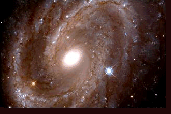UV in Interior Lighting of Spaceships Can Lead to
Infectious Diseases
by Duane Dunkerson
Immune suppression has been observed to occur in
astronauts. It has been attributed previously to
microgravity or stress.
Speculation on a Role for Photoimmunosuppression During
Space Missions by Daniel H. Hug, John K. Hunter, and
Duane D. Dunkerson.
Immunity suppression can weaken an astronaut's state of
health so that infections can start or can be worsened.
This article proposes that one possible component of
immune suppression has not been taken into account. UV
radiation from spacecraft interior lighting and special
spacecraft plant growth lamps contain a range of UV
wavelengths that may lead to immune suppression. This
immune suppression, called photoimmune suppression, was
discovered in mice around 1976.
The importance of consideration being given to UV
sources inside spacecraft increases as the duration of
the flight lengthens. Space missions of days, weeks and
months have or will be conducted. Under consideration
now are possible manned missions to Mars. Proposals for
growing the astronauts' food while enroute have been put
forth.
The aftereffects of a short exposure to the harmful UV
can last for weeks. It is possible that UV exposure
before launch while engaging in various outdoor
activities, can be affecting the astronauts long after a
mission commences.
Urocanic acid (UCA), a molecule found in the skin and
elsewhere, has been implicated as a photoreceptor for
the harmful UV. Once the UCA absorbs the UV, then
thereafter, in an unknown manner, immune suppression can
occur. If one has more UCA, the amount of immune
suppression can be increased.
Human beings in space have an increased immune
suppression as compared to their terrestrial levels of
immunity. Space motion sickness, weight loss, muscle
wasting, and protein catabolism ( protein destruction)
afflict astronauts. Protein malnutrition can arise from
the specific responses to motion sickness. The protein
catabolism occurring in astronauts is characterized by a
lessening in the amount of methionine found in the
astronauts' plasma. Methionine is a molecule used for
the making of proteins in the body. Less methionine
means more UCA. This increased UCA could find its way to
the skin of the astronauts. There the UCA could absorb
the UV from interior lighting or plant growth lamps that
could adversely affect the health of spacecraft
occupants.
Astronauts float about all parts of their living
quarters. Illumination lamps may be inches from them.
The astronauts often function in a "shirtsleeves"
environment that has them in T-shirts and shorts.
Acrylic diffusers on the light source are of benefit.
Grid diffusers pass the harmful UV. Filtered light from
the exterior of the spacecraft via portholes and
filtered light from the interior are presumed safe but
filters weaken with age.
Little consideration has been given in all sectors of
the workplace and home in regard to the harmful effects
of the prevalent fluorescent lighting's UV found in the
office, the production area, and in the domestic
settings. Such scant attention to earthbound light
sources may be repeated in orbital and deep space
activities.
To counter bone loss in astronauts and bacterial growth
in the spacecraft, and to promote vitamin formation, it
has been proposed to use UV radiation. Also, plant
growth in spacecraft has been planned for to provide
oxygen and food. These plant growth lamps and radiation
to promote the health of the astronauts could represent
a danger for the astronauts.
It is hazardous duty to be in illuminated floating and
restricted quarters for lengthy periods of time. It
would seem there might not be friendly confines for
space travel until the size of the craft increases
beyond the dimensions of glorified broom closets.

